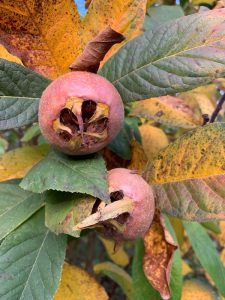The medlar tree (Mespilus germanica)
[Jaimie Sweetman is part of the Edible Forest located on the Yarra Valley Estate in Dixons Creek. There are regular tours of the Edible Forest – read more and book your place on a future tour.]
Also, read Robin Gale-Baker’s guide to growing medlars.
 The medlar tree (Mespilus germanica) is one of my absolute favourites, especially as Winter approaches. I love this tree because it is harvested in winter when not much else is.
The medlar tree (Mespilus germanica) is one of my absolute favourites, especially as Winter approaches. I love this tree because it is harvested in winter when not much else is.
The medlar is an ancient species and was once extremely popular in Europe during the Middle Ages. In fact, you would apparently have found them in most medieval monasteries and castles. Can you recognise the fruit from old paintings?
The medlar is in the same family as apples (the rose family). When apples started to be widely cultivated, medlars were largely forgotten about. This wasn’t because they don’t taste good though; rather, it was because they quickly perish once picked and thus need to be eaten straight off the tree or turned into preserves.
Medlars need to go through a cold period so they can ‘blet’ on the tree. [Editor: ‘Bletting’, meaning the softening of certain fleshy fruits, such as medlars and persimmons, beyond ripening, until the desired degree of sweetness/palatability is attained.] The cold softens them and some even say they become like rotten fruit. They taste like stewed apple though and can be turned into jams and jellies to preserve.
